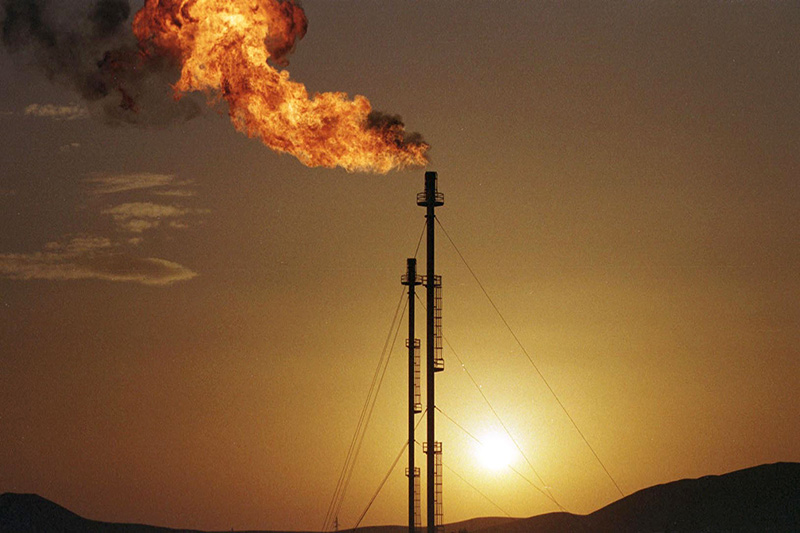Investing.com - Natural gas futures ended Friday’s session at a seven-day high, as upward momentum from Thursday’s bullish U.S. supply report continued to support prices.
On the New York Mercantile Exchange, natural gas futures for delivery in October rose 1% on Friday to settle the week at USD3.676 per million British thermal units.
Prices rose by as much as 1.4% earlier in the day to hit a session high of USD3.689, the strongest level since September 5. Nymex gas prices rallied 2% on Thursday to settle at USD3.638 per million British thermal units.
On the week, natural gas prices advanced 3.95%.
The U.S. Energy Information Administration said on Thursday that natural gas storage in the U.S. rose by 65 billion cubic feet last week, below market expectations for an increase of 66 billion cubic feet.
Inventories increased by 27 billion cubic feet in the same week a year earlier, while the five-year average change for the week is a build of 62 billion cubic feet.
Total U.S. natural gas storage stood at 3.253 trillion cubic feet as of last week, 1.4% above the five-year average for the same week and 5% below last year's unusually high level.
Early injection estimates for this week’s storage data range from 55 billion cubic feet to 68 billion cubic feet, compared to a 61 billion cubic feet increase during the same week a year earlier.
The five-year average for the week is a build of 74 billion cubic feet.
Meanwhile, natural gas traders continued to focus on tropical storm activity in the Gulf of Mexico, amid concerns over a disruption to supplies from the region.
The U.S. National Hurricane Center upgraded a storm system in the southwestern Gulf of Mexico into Tropical Storm Ingrid on Friday.
However, the agency said the storm was on course for landfall on Mexico's east coast, instead of threatening gas production facilities in the U.S. Gulf region.
Energy traders track tropical storm activity in the event it disrupts production in the Gulf of Mexico, which is home to nearly 5% of U.S. natural gas production.
Market players also monitored near-term weather forecasts to gauge the strength of demand for the fuel.
Updated weather forecasting models pointed to mostly normal to below-normal temperatures across most parts of the U.S. Northeast Midwest for the next ten days.
Elsewhere in the energy complex, light sweet crude oil futures for November delivery settled at USD107.54 a barrel by close of trade on Friday, losing 2.45% on the week.
Meanwhile, heating oil for October delivery fell 1.42% on the week to settle at USD3.115 per gallon by close of trade Friday.
On the New York Mercantile Exchange, natural gas futures for delivery in October rose 1% on Friday to settle the week at USD3.676 per million British thermal units.
Prices rose by as much as 1.4% earlier in the day to hit a session high of USD3.689, the strongest level since September 5. Nymex gas prices rallied 2% on Thursday to settle at USD3.638 per million British thermal units.
On the week, natural gas prices advanced 3.95%.
The U.S. Energy Information Administration said on Thursday that natural gas storage in the U.S. rose by 65 billion cubic feet last week, below market expectations for an increase of 66 billion cubic feet.
Inventories increased by 27 billion cubic feet in the same week a year earlier, while the five-year average change for the week is a build of 62 billion cubic feet.
Total U.S. natural gas storage stood at 3.253 trillion cubic feet as of last week, 1.4% above the five-year average for the same week and 5% below last year's unusually high level.
Early injection estimates for this week’s storage data range from 55 billion cubic feet to 68 billion cubic feet, compared to a 61 billion cubic feet increase during the same week a year earlier.
The five-year average for the week is a build of 74 billion cubic feet.
Meanwhile, natural gas traders continued to focus on tropical storm activity in the Gulf of Mexico, amid concerns over a disruption to supplies from the region.
The U.S. National Hurricane Center upgraded a storm system in the southwestern Gulf of Mexico into Tropical Storm Ingrid on Friday.
However, the agency said the storm was on course for landfall on Mexico's east coast, instead of threatening gas production facilities in the U.S. Gulf region.
Energy traders track tropical storm activity in the event it disrupts production in the Gulf of Mexico, which is home to nearly 5% of U.S. natural gas production.
Market players also monitored near-term weather forecasts to gauge the strength of demand for the fuel.
Updated weather forecasting models pointed to mostly normal to below-normal temperatures across most parts of the U.S. Northeast Midwest for the next ten days.
Elsewhere in the energy complex, light sweet crude oil futures for November delivery settled at USD107.54 a barrel by close of trade on Friday, losing 2.45% on the week.
Meanwhile, heating oil for October delivery fell 1.42% on the week to settle at USD3.115 per gallon by close of trade Friday.
